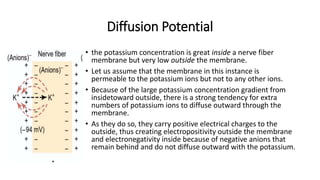1) Membrane potentials exist across cell membranes due to concentration gradients of ions like sodium, potassium, and chloride. The permeability of the membrane and concentration gradient of each ion determines the voltage of the membrane potential.
2) In nerve and muscle cells, the high intracellular potassium concentration compared to extracellular creates a diffusion potential of -94mV. The higher sodium concentration outside compared to inside creates a diffusion potential of +61mV.
3) At rest, the nerve membrane potential is -90mV due to higher permeability to potassium than sodium, the sodium-potassium pump maintaining ion gradients, and its electrogenic effect exporting more sodium than importing potassium.




















